2013 Peugeot 508 Hybrid turn signal
[x] Cancel search: turn signalPage 34 of 340
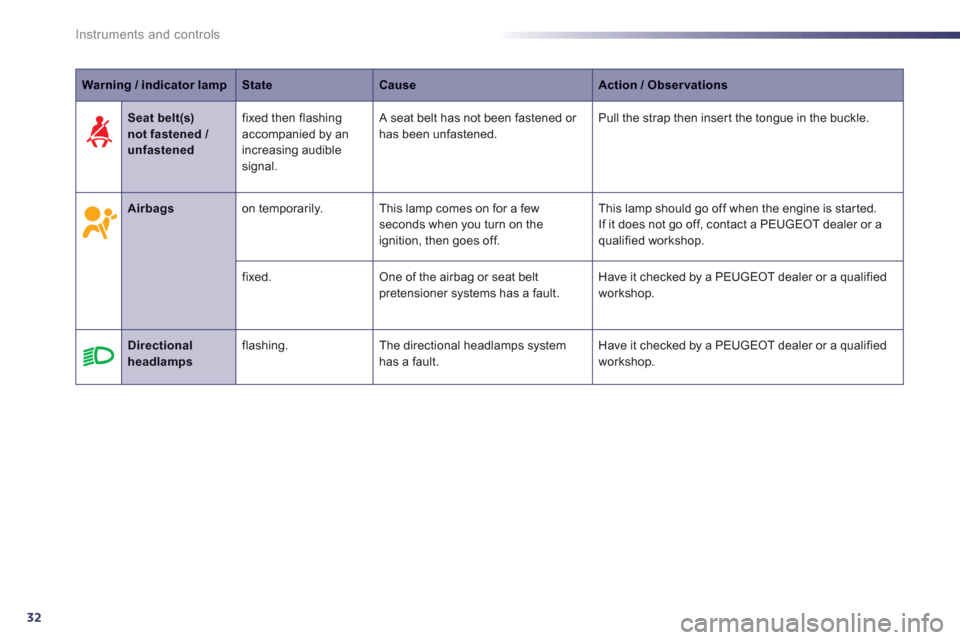
32
Instruments and controls
Warning / indicator lampStateCauseAction / Observations
Airbagson temporarily. This lamp comes on for a fewseconds when you turn on the
ignition, then goes off. This lamp should
go off when the engine is started.
If it does not go off, contact a PEUGEOT dealer or a qualified workshop.
fix
ed.One of the airbag or seat beltpretensioner systems has a fault.Have it checked by a PEUGEOT dealer or a qualified
workshop.
Directionalheadlampsflashing.The directional headlamps systemhas a fault.Have it checked by a PEUGEOT dealer or a qualified
workshop.
Seat belt(s) not fastened / unfastened
fixed then flashingaccompanied by anincreasing audiblesignal. A
seat belt has not been fastened or has been unfastened.Pull the strap then insert the tongue in the buckle.
Page 35 of 340
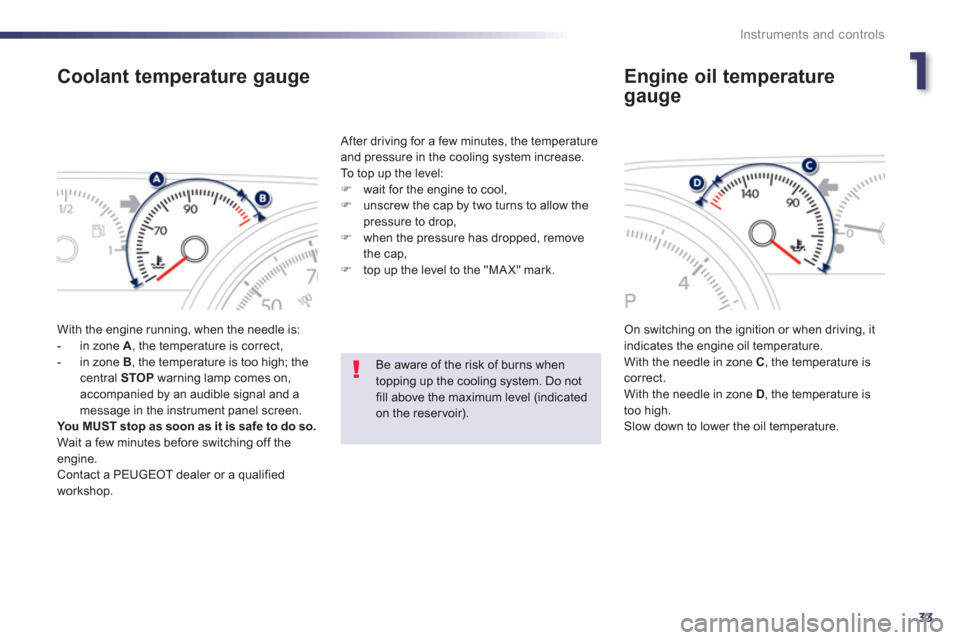
1
33
Instruments and controls
Coolant temperature gauge
With the engine running, when the needle is:
- in zone A
, the temperature is correct,
- in zone B, the temperature is too high; the central STOP
warning lamp comes on,accompanied by an audible signal and amessage in the instrument panel screen.You MUST stop as soon as it is safe to do so.
Wait a few minutes before switching off theengine.
Contact a PEUGEOT dealer or a qualified
workshop.
After drivin
g for a few minutes, the temperatureand pressure in the cooling system increase.
To top up the level:
Fwait for the engine to cool, Funscrew the cap by two turns to allow the
pressure to drop,
Fwhen the pressure has dropped, remove
the cap,
Ftop up the level to the "MA X" mark.
On switching on the ignition or when driving, it
indicates the engine oil temperature.
With the needle in zone C , the temperature is correct.
With the needle in zone D , the temperature is
too high.
Slow down to lower the oil temperature.
Engine oil temperature
gauge
Be aware of the risk of burns whentopping up the cooling system. Do not fill above the maximum level (indicatedon the reservoir).
Page 103 of 340
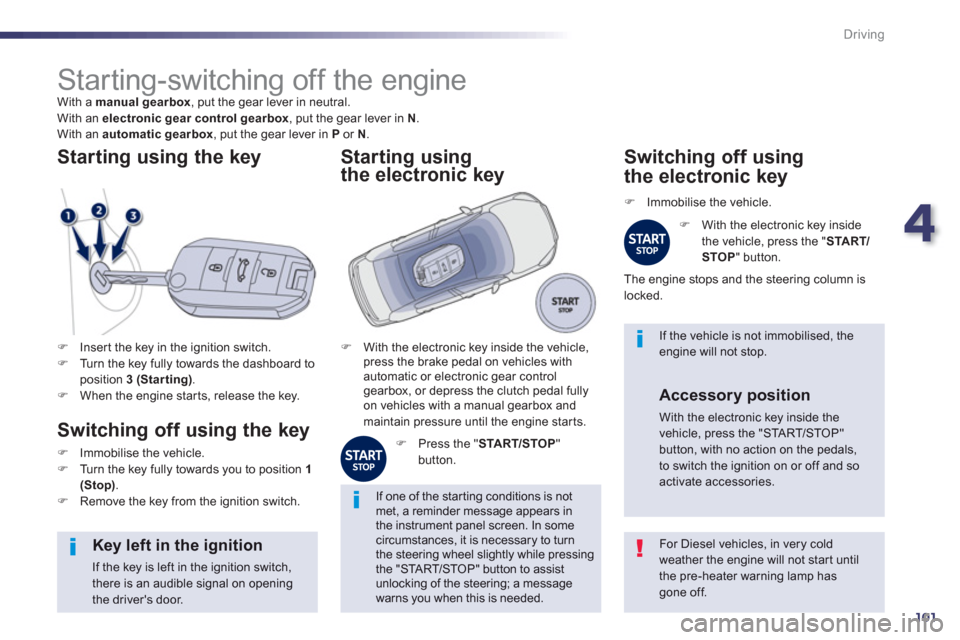
4
101
Driving
Starting-switching off the engine
With a manual gearbox
, put the gear lever in neutral.
With an electronic gear control gearbox, put the gear lever in N.
With an automatic gearbox
, put the gear lever in P
or N
.
FInser t the key in the ignition switch. FTurn the key fully towards the dashboard toposition 3 (Starting).FWhen the engine star ts, release the key.
Starting using the key
Switching off using the key
FImmobilise the vehicle. FTurn the key fully towards you to position 1(Stop)
. FRemove the key from the ignition switch.
For Diesel vehicles, in very cold weather the engine will not star t until the pre-heater warning lamp has
gone off.
Key left in the ignition
If the key is left in the ignition switch,there is an audible signal on opening the driver's door.
If one of the star ting conditions is not met, a reminder message appears inthe instrument panel screen. In somecircumstances, it is necessary to turn the steering wheel slightly while pressing the "STA R T/STOP" button to assist unlocking of the steering; a message warns you when this is needed.
If the vehicle is not immobilised, theengine will not stop. FWith the electronic key inside the vehicle,
press the brake pedal on vehicles with
automatic or electronic
gear controlgearbox, or depress the clutch pedal fully
on vehicles with a manual gearbox and
maintain pressure until the engine star ts.
Starting using
the electronic key
ggg
FPress the " STA R T/STOP"button.
Switching off using
the electronic key
F
Immobilise the vehicle.
F
With the electronic key inside
the vehicle, press the "START/
STOP"
button.
The en
gine stops and the steering column islocked.
Accessory position
With the electronic key inside the vehicle, press the "STA R T/STOP"button, with no action on the pedals, to switch the ignition on or off and so activate accessories.
Page 106 of 340

104
Driving
With the ignition on or the engine running,
to release the parking brake, pressthe brakepedal
, pullthen releasecontrol lever A
.
The full release of the parking brake
is confirmed by:
Manual release
- the braking warning lamp and
the P warning lamp in the controllever A
going off,
- displa
y of the message "Parking brake off".
I
f you pull the control lever Awithout pressing
the brake pedal, the parking brake will not
be released and a message appears in the
instrument panel. If necessar
y, you can make a maximum
applicationof the parking brake. It is obtained by means of a long pullon control lever A,
until you see the message "Parking brake
applied fully" and an audible signal is heard.Maximum application is essential:
- in the case of a vehicle towing a caravanor a trailer, if the automatic functions are
activated but you are applying the parkingbrake manually,
- when the slope you are parked on mayvary (e.g. on a ferry, on a lorry, during
towing).
Maximum application
Before leaving the vehicle, check that parking brake warning lamps in the instrument panel and in the control lever A
are on fixed (not flashing).
Never leave a child alone inside thevehicle with the ignition on, as they could release the parking brake.
Automatic application,
engine off
- illumination of the braking warning
lamp and of the Pwarning lamp in
the control lever A ,
- displa
y of the message "Parkingbrake on".
With the vehicle stationary, the parking brake is automatically applied when the engine is
switched off. The application of the parking brake is confirmed by:
In the case of towing, a loaded vehicleor parking on a gradient, make amaximum application of the parkingbrake then turn the front wheels towards the pavement and engage a gear whenyou park.
After a maximum application, the release time will be longer.
Page 118 of 340

116
Driving
Manual operation
FSelect position M for sequentialchanging
of the six gears.FPull the lever towards the + sign to change
up a gear. FPush the lever towards the -
sign to change
down a gear.
It is only possible to change from one gear to another if the vehicle speed and engine speedpermit; otherwise, the gearbox will operate
temporarily in automatic mode.
D disappears and the gears engaged appear in succession in the
instrument panel.
Invalid value during manual operation
This symbol is displayed if a gear
is not engaged correctly (selector
between two positions).
Stopping the vehicle
Before switching off the engine, you can engage position P
or Nto place the gearbox in
neutral.
In both cases, apply the parking brake to
immobilise the vehicle, unless it is programmed
to automatic mode.
Operating fault
When the ignition is on, amessage appears in the
instrument panel screen to indicate a gearboxfault.
In this case, the gearbox switches to back-up mode and is locked in 3rd gear. You may feel
a substantial knock when changing from Pto Rand from N to R
. This will not cause any
damage to the gearbox.
Do not exceed 60 mph (10 0 km/h), local speed
restrictions permitting.
Have it checked by a PEUGEOT dealer or a qualified workshop.
If the en
gine speed is too low or too high, the gear selected flashes for a few seconds, then
the actual gear engaged is displayed.
It is possible to change from position D(automatic) to position M (manual) at any time.When the vehicle is stationary or movingvery slowly, the gearbox selects gear M1automatically.
The spor t and snow programmes do not
operate in manual mode.
You risk damaging the gearbox:
- if you press the accelerator and brake pedals at the same time,
- if you force the lever from position Pto another position when the batteryis flat.If the lever is not in position P
, when the Pdriver's door is opened or approximately 45 seconds after the ignition is switchedoff, there is an audible signal and a message appears. FReturn the lever to position P;the audible signal stops and themessage disappears.
To reduce fuel consumption when stationary for long periods with the engine running (traffic jam...), positionthe gear lever at Nand apply theparking brake, unless it is programmed in automatic mode.
Page 142 of 340
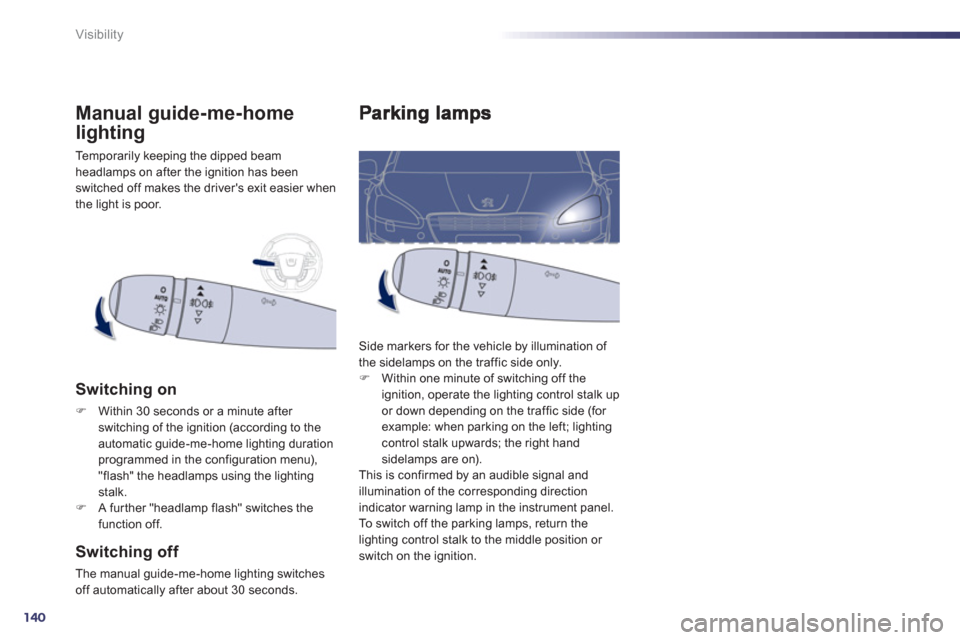
140
Visibility
Side markers for the vehicle by illumination of
the sidelamps on the traffic side only. F Within one minute of switching off the
ignition, operate the lighting control stalk upor down depending on the traffic side (for example: when parking on the left; lightingcontrol stalk upwards; the right hand sidelamps are on).
This is confirmed by an audible signal and
illumination of the corresponding direction
indicator warning lamp in the instrument panel.
To switch off the parking lamps, return the
lighting control stalk to the middle position or
switch on the ignition.
Temporarily keeping the dipped beam
headlamps on after the ignition has beenswitched off makes the driver's exit easier when
the light is poor.
Manual guide-me-home
lighting
Switching on
FWithin 30 seconds or a minute after
switching of the ignition (according to theautomatic guide-me-home lighting durationprogrammed in the configuration menu), "flash" the headlamps using the lighting stalk.FA further "headlamp flash" switches the
function off.
Switching off
The manual guide-me-home lighting switches
off automatically after about 30 seconds.
Page 143 of 340

5
141
Visibility
The sidelamps and dipped beam headlamps are
switched on automatically, without any action
on the part of the driver, when a low level of external light is detected or in certain cases of
activation of the windscreen wipers.
As soon as the brightness returns to a sufficient
level or after the windscreen wipers are switched
o
ff, the lamps are switched off automatically.
Automatic illumination of
headlam
ps
Activation
FTurn the ring to the "AUTO"position. The automatic
illumination of headlamps is accompanied by a message in the instrument panel screen.
Deactivation
FTurn the ring to another position.
Deactivation is accompanied by a message
in the instrument panel screen.
Association with automaticguide-me-home lighting
Association with automatic illumination of headlamps provides the guide-me-home lighting with the following additional options:
- selection of the lighting duration of 15, 30
or 60 seconds,
- automatic activation o
f guide-me-home lighting when the automatic illumination of
headlamps is in operation.
Operating fault
In the event of a fault with the sunshine sensor, the lighting comes on, this warning lamp
is displayed in the instrument panel and/or
a message appears in the instrument panel screen, accompanied by an audible signal.
Contact a PEUGEOT dealer or a qualified
workshop.
In fog or snow, the sunshine sensor maydetect sufficient light. In this case, the lighting will not come on automatically. Do not cover the sunshine sensor,coupled with the rain sensor and located in the centre of the windscreenbehind the rear view mirror; theassociated functions would no longer be controlled.
Programming
Selection of the duration of theguide-me-home lighting is done
in the configuration menu vehicle
parameters, in the instrument panel screen.
Page 225 of 340
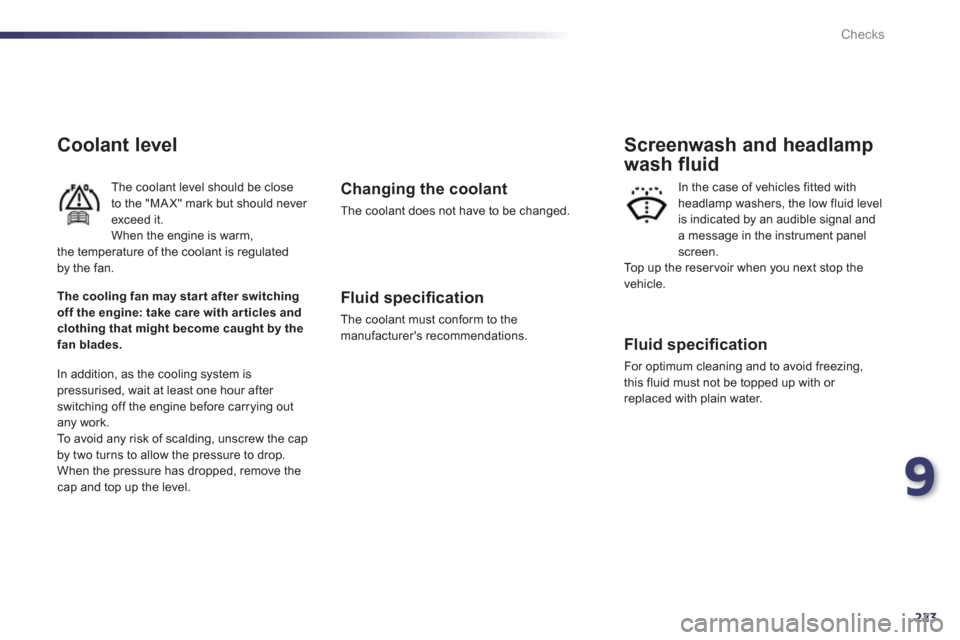
9
223
Checks
Coolant level
The coolant level should be closeto the "MA X" mark but should never exceed it.When the engine is warm,
the temperature of the coolant is regulated
by the fan.
In addition, as the cooling system is
pressurised, wait at least one hour after switching off the engine before carrying out
any work.
To avoid an
y risk of scalding, unscrew the cap
by two turns to allow the pressure to drop.When the pressure has dropped, remove thecap and top up the level.
Changing the coolant
The coolant does not have to be changed.
Fluid specifi cation
The coolant must conform to the
manufacturer's recommendations.
Fluid specifi cation
For optimum cleaning and to avoid freezing,
this fluid must not be topped up with or
replaced with plain water.
Screenwash and headlamp
wash fluid
In the case of vehicles fitted with
headlamp washers, the low fluid level is indicated by an audible signal anda message in the instrument panelscreen.
Top up the reser voir when you next stop the
vehicle. The cooling fan may star t after switchingoff the engine: take care with ar ticles andclothing that might become caught by thefan blades.